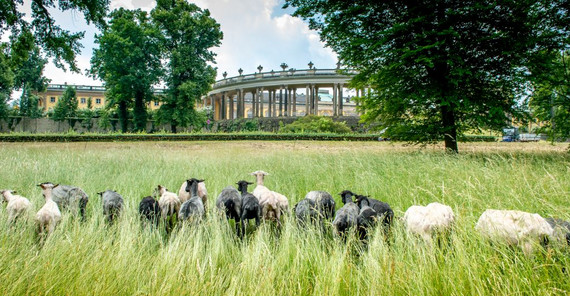Sheep are quite a rare sight in historic public parks. Some, however, have temporarily moved into Sanssouci Park. From July to November 2018, the Prussian Palaces and Gardens Foundation Berlin-Brandenburg (SPSG) initially used about 50 ruminants for pasture management. The associated five-year grazing project is supported by researchers of the working groups Biodiversity Research and Landscape Management as well as the Botanical Garden of the University of Potsdam.
Sheep are said to have already grazed in Sanssouci Park at the time of Frederick II - a tradition that was recently revived. The breeds Bentheimer Landschafe (also known as Landrace of Bentheim) and Pomeranian Coarsewool grazed opposite the court of honor of Sanssouci Palace, near the New Palace and the Roman Baths until November 2018. After the winter break, they will return in the spring of 2019. The flock will be looked after by a shepherd. The project is intended both as a contribution to the historic garden and to nature conservation.
Sanssouci Park is home to many endangered plants
The researchers observe the pastures, “to find out if and how the vegetation, for example through nutrient supply or browsing damage, is changing with this type of grazing,” says Dr. Michael Burkart, Scientific Director of the Botanical Garden. If Sanssouci Park was not part of the UNESCO World Heritage, the area would be one of the most outstanding nature reserves for meadows and dry grasslands in the state of Brandenburg. It boasts an exceptionally diverse nature with many endangered and rare plant species, such as campion or pigeon scabious.
For his master’s thesis, Jakob Schulz is recording the current plant stock on the areas that were selected for the sheep. He was able to identify and map over 100 species, including several endangered plants. More should be added in 2019. To be able to compare the plant stock later, a part of the fenced area remains unused by the sheep. The investigations are planned every year before grazing. The scientists are analyzing the initial conditions as well as developments with and without grazing. They are also examining how the areas are changing as a result of the weather conditions. Burkart expects grazing to increase biodiversity. “The closed sod breaks up through browsing and the feet of the sheep. This gives different seeds the opportunity to germinate, among them probably even endangered species. “Thus the animals significantly contribute to landscape and nature conservation. They are not a substitute for the lawnmower, though, because they only eat what they like.
Park visitors approve of the project
The researchers are investigating the impact of grazing on the floral biodiversity as well as the visitors’ reaction to the sheep. “We are particularly interested in how Potsdamers, who visit the park regularly, but also tourists perceive and appreciate the presence of the sheep, the changing landscape and the ecological impact on the meadows in the park,” explains Ariane Walz, head of the working group Landscape Management. For 10 days in July, student Melissa Oppenberger interviewed about 150 German-speaking visitors of Park Sanssouci for her geography bachelor thesis in October 2018. About 60% of them were visitors from Berlin and Brandenburg. She asked them, for example, whether they perceive the park as a cultural treasure, leisure or more as a “nature conservation area”. She also asked them if they knew about the grazing project and if the sheep were an enrichment – visually and also ecologically.
About one third of the respondents had heard about the project, 64% of the park visitors regarded the sheep as an enrichment. Walz finds it astounding that 92% of the interviewed people emphasized the park’s regulating role for the urban climate. At the same time, only 42% considered the park a refuge for rare and endangered plants. The visitors praised the fact that a shepherd looks after the animals and that the project promotes climate protection. In order to complete and expand the results, Oppenberger will conduct a second survey in 2019.
Sheep could protect the environment
If it is confirmed that the grazed areas have a more diversified vegetation than the ungrazed ones, it would have significant consequences. Flora and fauna would become more diverse: A greater variety of plants, for example, would allow more insects and fungi to settle. Prof. Michael Rohde, Garden Director of SPSG, welcomes the close, “neighborly” cooperation with the University of Potsdam in monitoring the grazing. He and the responsible district managers of the foundation read the first results of both the botanical records and the visitor survey with great interest. At present, they are discussing what they can deduce for Sanssouci Park and other historic gardens of SPSG.
The Project
The project studies the effects of sheep grazing in Sanssouci Park on botany and visitors and is a cooperation of the University of Potsdam and the Prussian Palaces and Gardens Foundation Berlin-Brandenburg (SPSG). It will be completed by the end of 2019. The planning and the methodical structure of the vegetation investigations were largely in the hands of Dr. Michael Burkart, custodian of the Botanical Garden, and Dr. Johannes Metz, currently Assistant Professor at the University of Hildesheim. The visitor survey is conducted by the Working Group Landscape Management headed by PD Dr. Ariane Walz and Dr. Torsten Lipp.
The Researcher
PD Dr. Ariane Walz studied geography at Julius-Maximilians-Universität Würzburg (JMU) and the University of Wales, Swansea. From 2012 – 2018, she was Assistant Professor for Landscape Management at the Institute of Earth and Environmental Science of the University of Potsdam and is now non-tenured Associate Professor.
E-Mail: ariane.walzuuni-potsdampde
Text: Dr. Barbara Eckardt
Translation: Susanne Voigt
Published online by: Agnes Bressa
Contact to the online editorial office: onlineredaktionuuni-potsdampde

